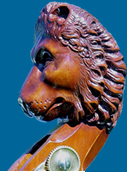|
|
|
|
|
|
LUTHIER
RANT
Fingerboards | Bass
Bars | Glues | Saddles
| Bridges
My Tuners | The
Sound Post | Regraduation
|
FINGERBOARDS I learned some valuable lessons about ebony in recent years - but first I want to relate a somewhat amusing anecdote concerning ebony and the computer. When I first started my business some years ago, my wife was trying to convince me that we needed a computer. Now, I was very happy working at a profession that could really be done the same way it was done three hundred years ago so I was quite reluctant. But she persisted and, when she played the angle that it was crucial for my son's education I gave in. My wife informed me that it would be quite useful for my business in many ways, such as in finding materials. In truth, I was kind of in the dark regarding how to find quite a few items. So we got the evil machine and the first thing she taught me was to do a rudimentary search. Well, I really didn't know a good source of ebony so I searched for "Ebony." Most savvy surfers will see where this is going. My jaw dropped at what appeared on my screen and I called my wife Barbara into the room and asked her if this was why the computer was so useful. Of course, the monitor displayed a young woman of African-American descent completely naked and in a less than modest pose. Her name was Ebony. At that time I was really did not know what constituted a good fingerboard. The blacker the better, right? One used to be able to get good straight black ebony, but was that a thing of the past? I sure needed a source though. There were a few wholesale distributors to luthiers that had good boards but they were quite expensive. I finally found a supplier that had fingerboards. He had a minimum order of 12 boards at about $90 apiece. That was less than half of what the distributors sold them for. Eureka! Still a dozen was more than I needed or could afford at the time. My friend Mike Shank of Shank's Strings offered to go half, so that simplified the deal. They came in and I was thrilled - truly black boards and quite oversized all around. They were a little warped but being overly thick you could true them out. I sent Mike his six and he promptly sent them back saying they were not good enough for him to use. He said the grain was all over the place. I was shocked - these were what I had been used to using in a large "professional" shop. Well, Mike was always a true stickler for quality and he had already learned what I was about to learn. I put one on an instrument and after much difficulty dressing it due to irregular grain patterns the fingerboard was playing fine. The player took his bass and was happy - these boards just took a little extra work. Yeah, right. Two months later the customer calls me and says the strings are buzzing - I tell him, no problem just bring it in and I'll take care of it. Bass comes in and sure enough there are a couple of high spots where there weren't before. That shouldn't have happened. I touch them up and send it back out. Now I am worried that I may have wasted a thousand dollars on these boards. I decide not to use any more for the time being and I ordered a few more from my local supplier at roughly twice the price. These came out of Germany - of course they didn't grow there it's just where they were chosen, dried and machined. There was no warping and they were very well machined, meaning that the gluing surface was very close to true and the curvature and relief of the upper surface was also quite accurate. Now of course the luthier needs to be able to do this machining, but it's nice to at least have the rough work done. The real difference though is in the grain pattern. The former boards were very black and these German-made ones had a bit of gray in them but if you looked at the backs of the boards in the sun you could see a world of difference. The black boards had tremendous irregularities that looked liked waves, swirls and knots. The Germans were completely even and straight in the grain pattern. I started using these boards and had no problems. The problem board came back again once more to bite me in the ass and I decided to replace it for free. What I finally figured out had to do with the wood moving. When you choose wood to make an instrument, generally straight vertical grain is best. One major reason for this is that when the wood shrinks or expands due to climatic conditions it does so in an even fashion. This helps prevent distortion or checking that may occur in woods that have irregularities in the grain. But does ebony move in the same way as a spruce top? Hell, yeah! That's why I had a headache in the first place - it was moving all over the place. Ebony may not move to exactly the same degree as spruce, but it sure doesn't take much to put an accurate fingerboard out of tolerance. So now when I choose a fingerboard, I take it out in the sun and view the flat side. By rocking it back and forth the refractions of the grain will clearly show any imperfections. Even a small knot or wave can cause problems. I am only interested in the very best and I know the difference. I keep one of those bad ones on hand just to show people the disparity between it and a fine one. It's truly profound. An old friend of mine once said, "Don't ever buy cheap shoes." That has always been a good lesson. page | 1 | 2 | |


| 359 Miller Avenue, Freeport, NY 11520 (516) 867 1395 · jbollbach17@gmail.com |
| [Directions to the workshop] |